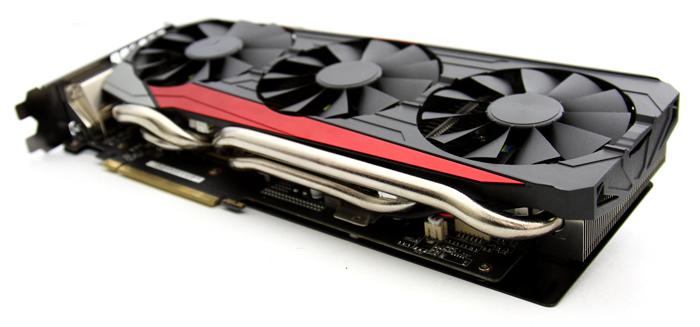Final Words & Conclusion
Final Words & Conclusion
It has been a wild ride for AMD lately, the Fury X release albeit being a lovely product got received rather luke-warm by the end-users. The price / performance ratio compared to the competition felt and is a little dim. Due to that I quite honestly expected AMD to release the Fiji Pro solution with a fully enabled GPU thus 4096 shader processors and perhaps a slightly lower clock. Unfortunately the number of compute units has been reduced to 56, thus 3584 shader processors and that shows in performance. However with its 64 ROPs in tact overall these cuts do not see to make a huge difference. Which brings a topic to debate, does the X have too few ROP units ? Regardless of that, we review the Fury today and there are many benefits with this product. The lack of liquid cooling makes this card use less power, it remains at acceptable cooling temps (air-cooled) and quite honestly does look better doesn't it ? Then the price, the STRIX edition will sell at roughly 549 USD (give or take a few tenners) and that places it slightly above the GeForce GTX 980. So the benchmark is the GTX 980 performance versus this Fury, and here the Fury just makes slightly more sense. Therefor I anticipate a price reduction on the 980 series fairly soon.
The Fiji Pro GPU
Lets talk reality first, 20nm fab nodes should have been here, they failed. So now the GPU industry is waiting on 16 and 14nm nodes to become ready for the big gun GPUs. So what do you do until that happens? Well, both Nvidia and AMD decided to put Godzilla on a chip, for AMD that is Fiji, and the end result is a chip that has close to 9 Billion transistors on the GPU (that's excluding HBM), and that is HUGE. The end result is a chip sized roughly 5x5cm; imagine this chip at 14nm, yup it would be half the size with reduced voltage needed. Regardless of size and complexity on the 28nm node AND added HBM on the die, you have to bow to AMD as they did manage to create a chip as powerful as Fiji is with its 4096 (XT) /3584 (Pro) shader processors. Despite its size, AMD also managed to keep power consumption under control.
Cooling & Noise Levels
So, Fiji is a big chip. Big chips produce heat when clocked high, and at 1000 MHz it is clocked high. The challenge at hand was that with HBM, the overall PCB production boards can be much smaller and thus cheaper. Air cooled however, that PCB needs to be long again as there is a lot of radiator surface area needed for cooling. For the STRIX edition, you can expect temps running in the 70 Degrees C zone under full gaming stress. I mean, that is OK and quite honestly I expected worse. At that point the card is a tiny bit audible though, not annoying or anything but not silent either.
Aesthetics
For this ASUS mode, we kinda like the looks of the new triple fan based DirectCU III cooler. It is a good looking product , the shielding and the PCB is just lovely in its matte black and ultra-clean design. So yes, overall it is a good looking product with a dark matte PCB and grey/black red cooler accents. Nice addition is the STRIX LED lit logo, albeit I rather see it on or off, not fading all the time. The backplate is done right, lots of spacing, gaps and meshes and a clear GPU area. So while it looks cool and protects the backside, it id not obstructing airflow and thus trapping heat. Overall it is an aesthetically pleasing product. Looks however are personal, that I have to mention.
Power Consumption
While the overall power consumption is spicy, the card is rated by us as having a ~275 TDP, depending on the workload, actually a notch lwoer compared to the Fury X. Compared to the last gen 290X and 390X, that is roughly the same power draw. So while it's a substantial wattage, the performance per watt ratio has improved significantly as both these cards utilize the same amount of power. Again, with such a huge chip and included liquid cooling (which draws power as well), things are not looking bad at all. That TDP will make running multi-GPU solutions a bit more complicated. With two cards in Crossfire mode we think an 850~900 Watt PSU would be sufficient. So yeah, it's not great to have a GPU consuming this much power, but it could have been a lot worse. So I am good with this.
Game Performance
The Radeon R9 Fury was targeted against the GeForce GTX 980 and we do think it is an excellent 2560x1440 card. In that resolution the performance definitely is very decent. Fury seems to behave well once it reaches WHQD and complex image quality settings. Once Ultra HD kicks in, you really want the X model though. That leaves open the 4GB discussion. In Ultra HD you are bound to run out of graphics memory fairly fast. Remember though, most of the data that resides on the framebuffer is cached data, that prevents things like swapping files from your HDD/SSD. Not all cached data is used and in most scenarios when you run out of graphics memory it just doesn't matter. It does start to matter when you have Ultra HD Texture packs and weird AA modes. If you want 8x MSAA, sure, your rendered frames will start swapping back and forth in graphics memory to do its thing, causing a slowdown, normally. However, with HBM, you have extremely low latency graphics memory that is seriously fast. So if these frames are moved back and forth in the framebuffer, they will gain from the increased bandwidth and that can alleviate the performance loss you'd normally get. It is a bit brute force, but everything about Fiji is just that, brute force performance. I feel the 4 GB is sufficient, the numbers back that up. But sure, to be a little more secure at Ultra HD, graphics memory wise I would have liked to have seen a 6GB or 8GB model. But that probably would have been too complicated on-die wires and expenses wise, so we can understand the decision made. But hey, performance wise really there's not one game that won't run seriously good at Ultra HD and that remains a fact.
Overclocking
Overclocking then. Current restrictions are voltage adjustment for both GPU and memory, as well as frequency changes on the HBM memory. In the future we'll have to see how tweaking support on that will pan out but right now it is not looking very good. The GPU voltage is going to be trivial here though. ASUS does offer solder traces for VGA voltage tweaking, but that requires hard-wiring the product, not rrecommended for 99.999% of you guys. With a bit of luck you will get the GPU clocked at 1100 MHz stable. Tweaking memory is not an option.
Concluding
The R9 Fury was released completely out of the blue, only two board partners jumped onto the bandwagon and the embargo date was way sooner then expected, hence we had a very hard time securing a sample. For this release, AMD simply didn't take care of arringing samples or even hosted a product briefing, the message was hey .. talk to the AIB partners. For the second biggest GPU release of the year from AMD, this was a surprising behavior to see. Last week was disappointing at many levels from both AIB and AMD side, so albeit three days late we do hope you enjoyed this Fury review. The interesting thing is, I like the air-cooled Fury better then a Fury X. Honestly I did not see that one coming. But it just makes more sense as this product is cheaper, better looking and competing with the GeForce GTX 980 in both price and performance. I do want to make a side-note here though, the GTX 980 overall is offered in factory clocked higher products, the Fury we tested is clocked at reference performance. The Radeon R9 Fury is a nice card that will do its job at WHQD well. For Ultra HD this product still makes sense as well as the performance really isn't that much lower compared to the Fury X. Looking at FCAT frametime analysis, well we see nothing that worries us. Very good results there. Overall ASUS has a terrific offering with the new Dirtect CU III cooler, the Fiji GPU is a big graphics processor though and it will run hot. But it all remains okay enough though. Overall we can certainly recommend the Radeon R9 Fury if it fits your budget and brand preference. For 549 USD you do receive a product that remains very capable. Much like the X, the one oversight is HDMI 2.0, well the lack of it. Very nice to see is that ASUS included a DVI connector ! Overall it the ASUS Radeon R9 Fury is a competitive card that is battling the GeForce GTX 980 from Nvidia. For those wondering and in the 2560x1440 arena, we do like to suggest you to look at the R9 390X as well, priced at least a 100 bucks cheaper that product might make a little more sense. So the Fury is a nice release, and we like very much what ASUS has done with the product overall.
“You Know Nothing, Jon Snow”
Recommended Downloads
Sign up to receive a notice when we publish a new article
Or go back to Guru3D's front page


